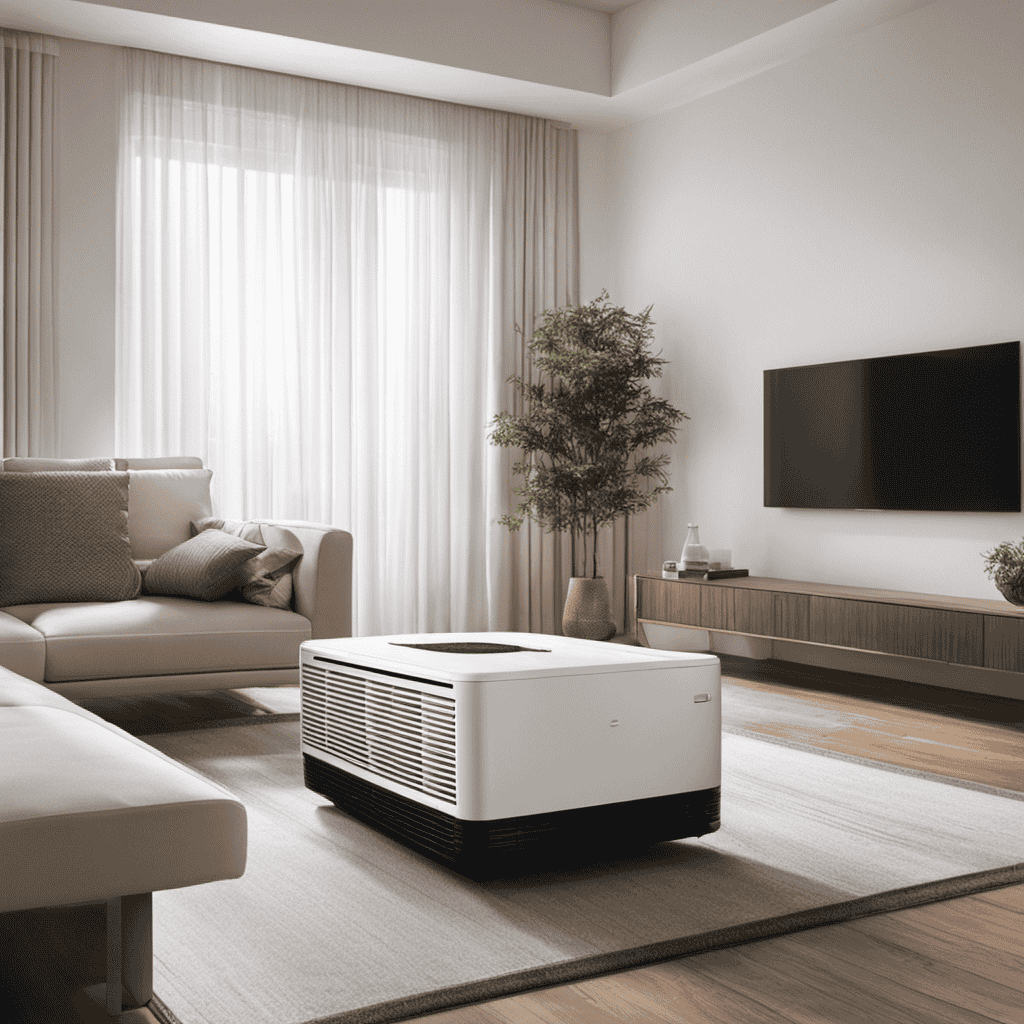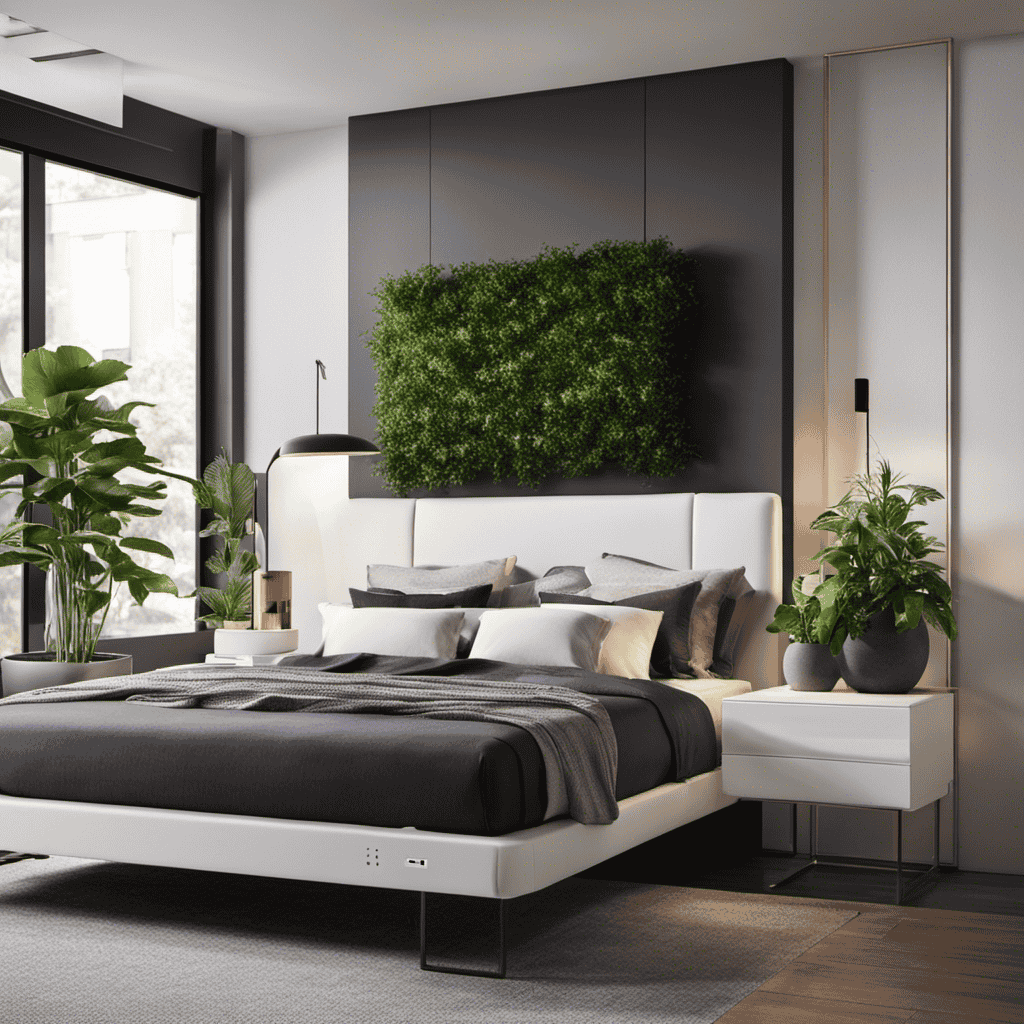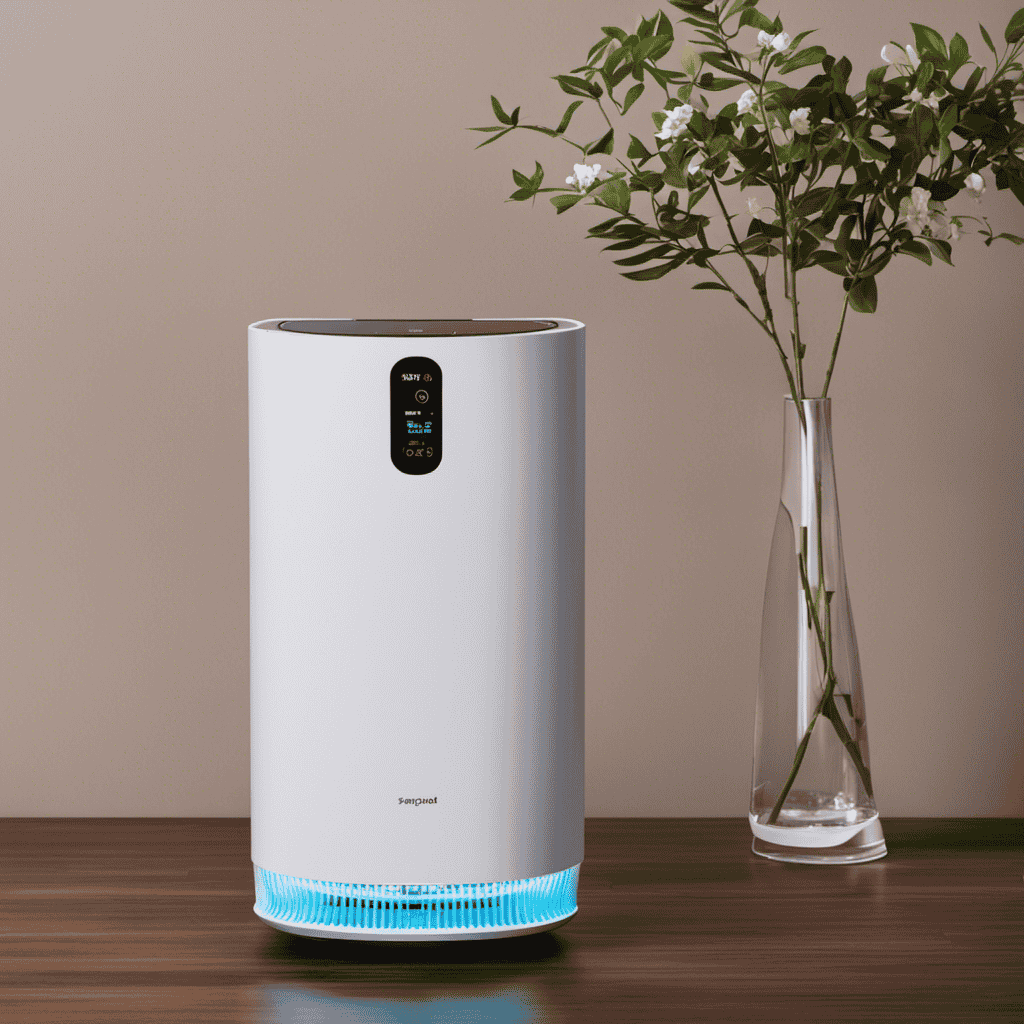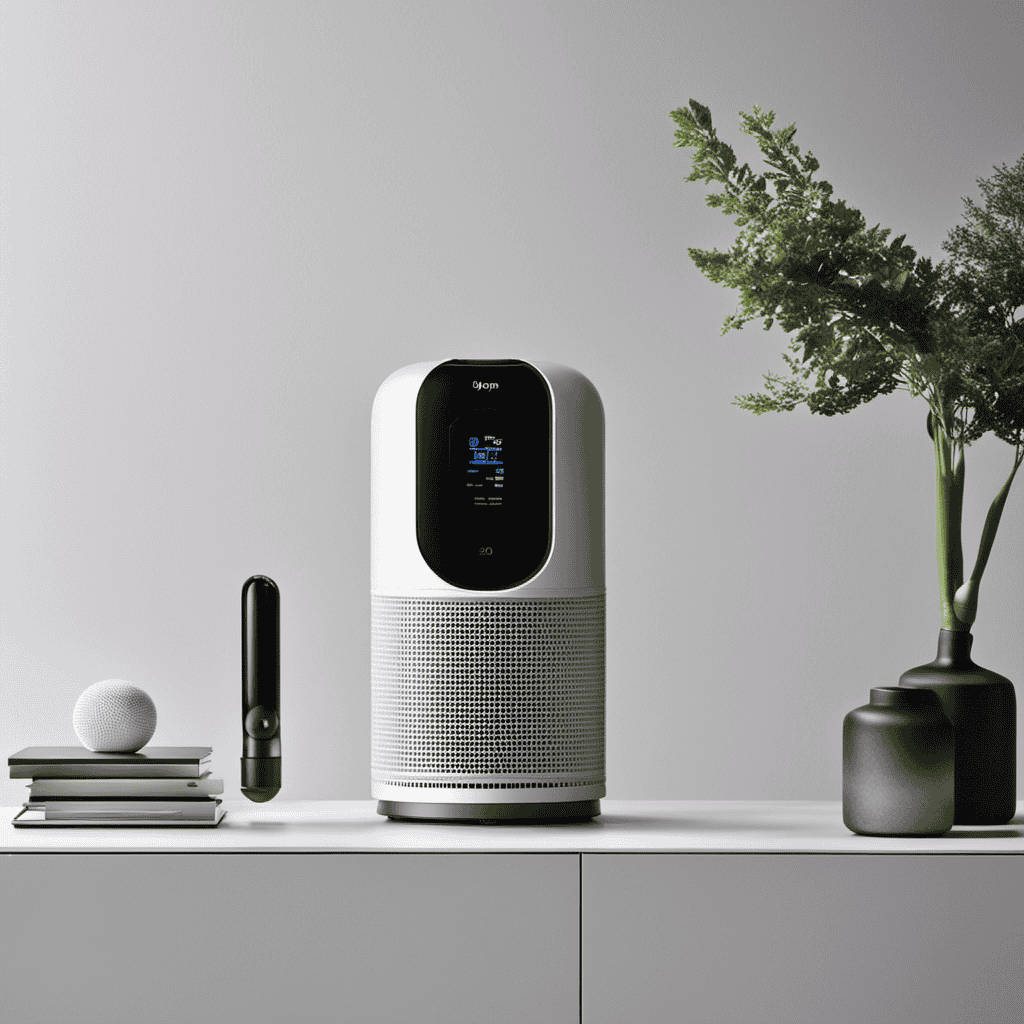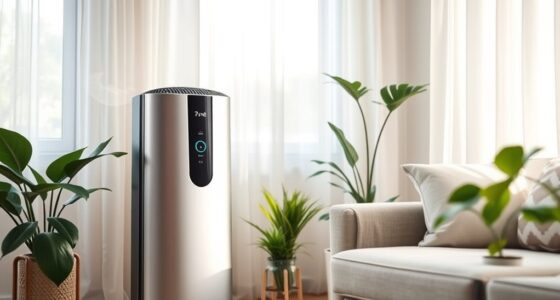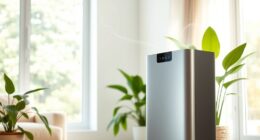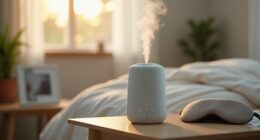As an individual concerned about the air quality within my living space, I frequently ponder the optimal location for an air purifier. Identifying a location that enhances its performance and efficacy is crucial.
In this article, we will explore the optimal placement for an air purifier in a room. By considering factors such as room size, potential sources of pollution, and the needs of individuals in the room, we can ensure that our air purifier is placed in the right location to circulate clean and fresh air throughout our living space.
Key Takeaways
- Evaluating the room size and layout is important in determining the placement of an air purifier.
- Placing the air purifier near areas with worse air quality can help improve the overall air quality in the room.
- Avoiding obstacles or furniture that obstruct airflow and placing the air purifier in a central location can ensure optimal effectiveness.
- Regularly monitoring and adjusting the placement of the air purifier, cleaning or replacing filters, and maintaining the surrounding area can help maintain optimal performance.
Consider the Size of the Room
You should consider the size of the room when deciding where to place an air purifier. The room layout plays a crucial role in determining the effectiveness of the air purifier.
A larger room may require a more powerful air purifier with a higher Clean Air Delivery Rate (CADR) to effectively clean the air. On the other hand, a smaller room may be adequately served by a compact air purifier.
Evaluating the air quality is also essential in determining where to place the air purifier. If the air quality is worse near a specific area, such as near a window or a source of pollution, it would be wise to position the air purifier in that area to target and eliminate the contaminants effectively.
Identify Potential Sources of Indoor Air Pollution
Identify potential sources of indoor air pollution so you can determine the best placement for an air purifier in your space. Indoor air pollution can come from various sources and can have potential health effects if not addressed.
Here are three common indoor pollutants to consider:
-
Tobacco smoke: Smoking indoors can release harmful chemicals and toxins into the air, which can lead to respiratory issues and other health problems.
-
Volatile Organic Compounds (VOCs): These are chemicals found in many household products such as cleaning agents, paints, and furniture. VOCs can cause irritation to the eyes, nose, and throat, and may even lead to long-term health effects.
-
Pet dander and allergens: If you have pets, their dander and allergens can contribute to poor indoor air quality. These particles can trigger allergies and asthma symptoms in sensitive individuals.
Place the Air Purifier Near the Source of Pollution
Placing the air purifier near the source of pollution can effectively remove indoor pollutants and improve air quality. When deciding where to place your air purifier, it is important to consider the ideal distance and optimal filtration. By positioning the purifier close to the source of pollution, you can ensure that the air is efficiently cleaned before it spreads throughout the room. To provide you with a clear understanding, here is a table showcasing the recommended placement for different sources of indoor pollution:
| Source of Pollution | Ideal Distance from Air Purifier |
|---|---|
| Kitchen | 2-3 feet |
| Smoking area | 4-5 feet |
| Pet area | 3-4 feet |
Avoid Placing the Air Purifier Near Obstacles or Furniture
When it comes to maximizing the effectiveness of an air purifier, ideal placement is key.
To ensure optimal performance, it is important to avoid placing the air purifier near obstacles or furniture that could obstruct the airflow.
Additionally, safety considerations should be taken into account when deciding where to place the air purifier, such as keeping it away from children or pets to prevent any accidents or damage.
Ideal Placement for Effectiveness
To maximize the effectiveness of your air purifier, you should consider placing it in a central location in the room. This allows the purifier to circulate the air more efficiently and remove pollutants effectively.
Here are three factors to consider for the ideal placement of your air purifier:
-
Ideal height: It is recommended to place the air purifier at least a foot above the ground. This helps to capture airborne pollutants more effectively, as they tend to settle closer to the floor.
-
Noise level: Take into account the noise level of the air purifier when choosing its placement. Keep it away from areas where you spend a lot of time, such as your bed or workspace, to minimize any disturbance caused by the purifier’s noise.
-
Accessibility: Ensure that the air purifier is easily accessible for maintenance and filter replacement. Placing it near an outlet will also make it convenient to plug in and operate.
Safety Considerations When Placing
Now that we’ve discussed the ideal placement for an air purifier in terms of effectiveness, let’s take a closer look at the safety considerations when placing one in a room.
It’s important to think about potential hazards to ensure the air purifier is not only efficient but also safe to use.
One key consideration is to avoid placing the air purifier near any flammable materials or heat sources. This includes keeping it away from candles, stoves, or space heaters. Additionally, avoid placing it in an area where it could be easily knocked over or damaged.
Another important safety consideration is to ensure proper ventilation around the air purifier. Make sure there is enough space around it for air to flow freely and for the unit to operate efficiently. Blocking the airflow can cause overheating or reduce the effectiveness of the purifier.
Determine the Optimal Height for the Air Purifier
When it comes to determining the optimal height for an air purifier, there are a few key factors to consider.
Firstly, you’ll want to decide whether it should be placed on a tabletop or on the floor.
Secondly, you’ll need to determine whether it’s best to position it near or far from other objects in the room.
Lastly, the question of whether the air purifier should be placed at eye level or lower is also important to address.
These considerations will help ensure that you get the most effective and efficient performance from your air purifier.
Tabletop or Floor
You should consider whether a tabletop or floor air purifier would be more suitable for your needs. When deciding between the two, there are a few factors to consider:
-
Size and Portability: Tabletop air purifiers are smaller and more lightweight, making them easy to move around and place on different surfaces. They are ideal for smaller rooms or for those who want the flexibility to move the purifier from one room to another. On the other hand, floor air purifiers are larger and more powerful, making them suitable for larger rooms or open spaces.
-
Coverage Area: Tabletop air purifiers are designed to purify the air in a specific area, typically around 100-300 square feet. If you have a smaller room or a specific area where you want to improve air quality, a tabletop purifier might be the better option. Floor air purifiers, on the other hand, can cover larger areas, often up to 500 square feet or more.
-
Noise Level: Tabletop air purifiers tend to be quieter compared to floor air purifiers. If you prefer a quieter environment, especially in areas like bedrooms or offices, a tabletop purifier might be more suitable. Floor air purifiers, although more powerful, can produce more noise due to their larger size and stronger air circulation.
Consider these factors when deciding between a tabletop or floor air purifier, as they can help you choose the option that best fits your specific needs and preferences.
Near or Far
Consider whether you would like the air purifier to be placed near you or far away from you. When deciding on the ideal distance for your air purifier, there are a few placement options to consider. Here is a table that provides a visual representation of these options:
| Placement Options | Pros | Cons |
|---|---|---|
| Near | – Removes pollutants quickly – Easy access for maintenance | – May create noise – Occupies space |
| Far | – Reduces noise – Doesn’t occupy space | – Takes longer to purify air – Less immediate impact |
As you can see, placing the air purifier near you has the advantage of removing pollutants quickly and providing easy access for maintenance. However, it may create noise and occupy space. On the other hand, placing it far away reduces noise and doesn’t occupy space, but it takes longer to purify the air and has less immediate impact. Now, let’s discuss whether the air purifier should be at eye level or lower.
Eye Level or Lower?
To get the best results, place the air purifier at eye level or lower. This ensures that the purifier can effectively clean the air at a height where most pollutants tend to settle. Placing it higher may result in the purifier not being able to effectively capture these pollutants.
Here are three reasons why placing the air purifier at eye level or lower is the optimal height:
-
Improved air circulation: Placing the purifier at eye level or lower allows for better distribution of purified air throughout the room. This ensures that all occupants can breathe cleaner air, reducing the risk of respiratory issues.
-
Enhanced efficiency: By positioning the purifier at eye level or lower, it can more efficiently capture pollutants that are closer to the ground, such as pet dander, dust mites, and pollen.
-
Convenience: Placing the air purifier on a tabletop or floor makes it easily accessible for maintenance and filter changes. It also reduces the risk of accidental tipping or damage.
Position the Air Purifier in a Central Location
Place the air purifier in a central location for optimal effectiveness. Finding the ideal height for your air purifier is crucial to maximize its performance. Generally, it is recommended to position it at least a foot above the ground to allow better air circulation. This way, the purifier can efficiently capture airborne particles and allergens.
Additionally, consider the noise level when deciding on the placement. Keep the air purifier away from areas where you spend most of your time, like your bedside table or office desk, to minimize any potential disturbances.
A central location helps distribute the purified air evenly throughout the room, ensuring you can breathe cleaner and fresher air no matter where you are.
Place the Air Purifier Away From Drafts or Open Windows
When it comes to optimal air purifier placement, it is important to consider avoiding air flow and drafts. Placing the air purifier away from open windows or areas where drafts are present can help prevent the purifier from being less effective.
Avoid Air Flow
Make sure you don’t place the air purifier in a spot where there is too much air flow. The ideal positioning for an air purifier is in a location where it can effectively circulate the air in the room without any restrictions.
Here are three reasons why airflow restriction should be avoided:
-
Reduced effectiveness: Placing the air purifier in an area with high air flow can hinder its performance. The constant movement of air can make it difficult for the purifier to effectively capture and filter pollutants.
-
Uneven purification: If the air purifier is placed in a spot with strong air flow, it may only clean a small portion of the room while neglecting other areas. This can lead to uneven purification and compromise the overall air quality.
-
Increased noise levels: Air purifiers are designed to operate quietly. However, placing them in areas with strong air flow can disrupt the airflow, causing the purifier to work harder and generate more noise.
To ensure optimal air purification, it is important to find a location with minimal air flow and avoid any restrictions that may hinder the purifier’s performance.
Optimal Purifier Placement
Now that we understand the importance of avoiding air flow when placing an air purifier, let’s discuss the optimal purifier placement and its effectiveness based on size.
When it comes to the size of the purifier, it’s crucial to choose one that is appropriate for the room. A purifier that is too small may not be able to effectively clean the air, while one that is too large may consume unnecessary energy. To determine the optimal size, consider the square footage of the room and the Clean Air Delivery Rate (CADR) of the purifier.
As for placement, it’s recommended to position the purifier in an area where it can efficiently circulate the air. This could be near the center of the room or close to the source of pollutants.
Avoid Placing the Air Purifier in Direct Sunlight
To prevent damage to your air purifier, it is important to avoid placing it in direct sunlight. The ideal positioning of an air purifier is crucial for its effectiveness. Here are three reasons why you should avoid placing your air purifier in direct sunlight:
-
Heat damage: Direct sunlight can cause the internal components of the air purifier to overheat, which can reduce its performance and lifespan.
-
Fading and discoloration: Prolonged exposure to sunlight can lead to fading and discoloration of the air purifier’s exterior, which can affect its aesthetic appeal.
-
UV radiation: Sunlight contains harmful UV radiation that can degrade the filter material in your air purifier. This degradation can reduce its ability to effectively capture pollutants.
By avoiding direct sunlight, you can maintain the optimum performance and longevity of your air purifier.
Now, let’s consider the noise level of the air purifier and its impact on your living space.
Consider the Noise Level of the Air Purifier
When choosing an air purifier, you’ll want to consider the noise level so it doesn’t disrupt your peaceful living environment. An air purifier that emits loud noise can be a major distraction, especially if you plan on using it in a bedroom or office space. To help you make an informed decision, I have created a table below that compares the noise levels of different air purifiers. This will assist you in finding one that suits your needs and ensures a quiet environment. Additionally, it’s important to regularly maintain your air purifier to avoid any unnecessary noise or performance issues. Here are a few maintenance tips: clean or replace the filters as recommended by the manufacturer, regularly wipe down the exterior of the unit, and keep the surrounding area free from dust and debris. By following these tips, you can enjoy the benefits of clean air without any distractions.
| Air Purifier Model | Noise Level (dB) | Suitable For |
|---|---|---|
| Model A | 25 dB | Bedrooms, Offices |
| Model B | 40 dB | Living Rooms, Kitchens |
| Model C | 50 dB | Basements, Workshops |
Ensure Proper Ventilation in the Room
When it comes to maximizing the efficiency of an air purifier, optimal placement and considering air circulation are key factors to consider.
Placing the purifier in an area where it can effectively capture and filter the air is crucial for its performance.
Additionally, ensuring proper air circulation throughout the room helps distribute the purified air more effectively, providing better results in terms of air quality.
Optimal Placement for Efficiency
The best spot to place the air purifier is near a source of air circulation, such as a window or an air vent. This ensures optimal air filtration and maximizes the benefits of proper placement.
Here are three reasons why:
-
Proximity to a window allows the air purifier to capture outdoor pollutants and prevent them from entering the room. Fresh air from outside can be drawn in, improving the quality of the indoor air.
-
Placing the air purifier near an air vent allows it to work in conjunction with the HVAC system. The purifier can capture any pollutants that may be circulating through the ducts, providing cleaner air throughout the entire space.
-
Strategic placement near a source of air circulation ensures that the purifier can effectively distribute clean air throughout the room. By placing it near a window or air vent, the purifier can capture and filter air that is already in motion, preventing stagnant pockets of air and improving overall air quality.
Consider Air Circulation
Placing the air purifier near a window or air vent allows for better distribution of clean air throughout the space. When considering the positioning of your air purifier, it is important to take into account airflow optimization. By strategically placing the purifier near a window or vent, you can take advantage of the natural air movement in your room, maximizing the effectiveness of the device. To further illustrate the importance of airflow, let’s take a look at the following table:
| Positioning Considerations | Airflow Optimization |
|---|---|
| Near a window | Increases air circulation and brings in fresh air |
| Near an air vent | Enhances distribution of clean air throughout the room |
| Away from obstacles | Allows for unobstructed airflow and better purification |
As you can see, proper positioning can significantly impact the performance of your air purifier. However, it is important to avoid placing the air purifier in high humidity areas, as we will discuss in the next section.
Avoid Placing the Air Purifier in High Humidity Areas
To avoid potential damage, don’t position your air purifier in areas with high humidity. High humidity can have a negative impact on the performance and lifespan of your air purifier. Here are three reasons why you should avoid placing your air purifier in high humidity areas:
-
Reduced efficiency: High humidity levels can make it harder for the air purifier to effectively remove pollutants from the air. The excess moisture in the air can interfere with the purifier’s filters, reducing their ability to capture particles.
-
Mold growth: Excessive humidity creates a conducive environment for mold growth. If your air purifier is constantly exposed to high humidity, it can become a breeding ground for mold, which can affect the air quality and even damage the device.
-
Potential damage: Exposing your air purifier to high humidity can lead to internal damage, such as corrosion or electrical malfunctions. This can shorten the lifespan of the purifier and require costly repairs or replacements.
Considering these factors, it is crucial to position your air purifier in an area with optimal humidity levels to ensure its optimal performance and longevity.
When it comes to positioning your air purifier, it is also important to consider the safety of pets or children.
Position the Air Purifier Away From Pets or Children
Keep your air purifier out of reach of pets and children to prevent any potential accidents or damage.
When it comes to the ideal height for placing your air purifier, it is generally recommended to keep it at a level where it can effectively circulate the air in the room. This typically means placing it at a height of around 2-3 feet off the ground.
As for the noise level, it is important to consider that some air purifiers can produce a noticeable amount of noise, especially when running at higher speeds. To minimize any disturbance, you may want to position the air purifier away from areas where people frequently gather or sleep.
Taking these factors into account will help ensure that the air purifier functions optimally while also considering the comfort of those in the room.
Consider the Specific Needs of Individuals in the Room
Considering the specific needs of individuals in the room, it’s important to choose an air purifier that addresses their particular concerns, such as allergies or respiratory issues. Once you have the right air purifier, it’s equally important to consider its optimal placement for allergies and the overall performance.
Here are three key factors to consider when deciding where to place your air purifier:
-
Proximity to the source: If you have allergies triggered by specific allergens like pet dander or pollen, it’s best to place the air purifier near the source. For example, if you have a pet, placing the purifier in the same room will help capture and filter out the pet allergens effectively.
-
Airflow and circulation: Placing the air purifier in an area with good airflow and circulation will ensure that the purified air is distributed evenly throughout the room. Avoid placing it in corners or behind furniture that may obstruct the airflow.
-
Distance from walls and objects: To optimize the performance of your air purifier, it’s recommended to place it at least a foot away from walls, furniture, or any other objects. This allows for better air intake and prevents any obstruction to the airflow.
Place the Air Purifier Where It Can Circulate Air Effectively
Placing the air purifier where it can circulate air effectively ensures optimal performance. The ideal positioning for an air purifier is in a central location of the room, away from walls and furniture that may obstruct air flow.
It is important to maximize air flow to ensure that the purifier can effectively capture and filter airborne particles. Avoid placing the purifier in corners or near curtains, as these can create stagnant areas where the air may not circulate properly. Additionally, keep the purifier at least a few feet away from other objects to allow for proper air intake and exhaust.
Regularly Monitor and Adjust the Placement of the Air Purifier
It’s important to regularly monitor and adjust where I position the air purifier to ensure optimal performance. Here are three key factors to consider when monitoring and adjusting the placement of the air purifier:
-
Proximity to pollution sources: I make sure to place the air purifier near potential sources of pollutants, such as windows, doors, or areas with high traffic. This helps to capture and filter out the pollutants effectively.
-
Airflow direction: I pay attention to the airflow in the room and position the air purifier in a way that allows it to circulate the air efficiently. Placing it in the center of the room or near air vents can help achieve better airflow distribution.
-
Room size and air purifier capacity: I consider the size of the room and the capacity of the air purifier. It’s important to choose an air purifier that is suitable for the room size to ensure it can effectively clean the air.
Frequently Asked Questions
Can I Place the Air Purifier Near a Window?
I wouldn’t recommend placing the air purifier near a window, as it may disrupt natural ventilation. Additionally, keeping it away from plants is better to prevent any potential interference or blockage.
Should I Place the Air Purifier on the Floor or on a Higher Surface?
I prefer placing the air purifier on a higher surface in the room. This allows for better air circulation and coverage. Plus, it keeps it out of reach from kids and pets.
Can I Place the Air Purifier in a Corner of the Room?
Placing the air purifier in a corner of the room is a viable option. However, it is essential to consider the size of the room. In small rooms, corners may restrict airflow, while in large rooms, corners can help maximize coverage.
Is It Safe to Place the Air Purifier Near Electronic Devices?
It’s safe to place the air purifier near electronic devices as long as there’s enough space for airflow. However, it’s important to consider the noise level of the purifier, especially if you want a quiet one for use near electronics.
Can I Place the Air Purifier in a Room With High Humidity?
Yes, you can place the air purifier in a room with high humidity. However, it’s important to consider proper air purifier maintenance to prevent any damage caused by excess moisture. Additionally, be aware of any potential increase in noise levels.
Conclusion
In conclusion, when it comes to placing an air purifier in a room, there are several factors to consider.
It’s important to identify potential sources of indoor air pollution and position the purifier near those sources for optimal effectiveness.
Additionally, the height and placement of the purifier should be carefully considered to ensure proper air circulation.
One interesting statistic to note is that according to the Environmental Protection Agency, indoor air can be up to 5 times more polluted than outdoor air.
This highlights the importance of having a well-placed air purifier to improve indoor air quality.
